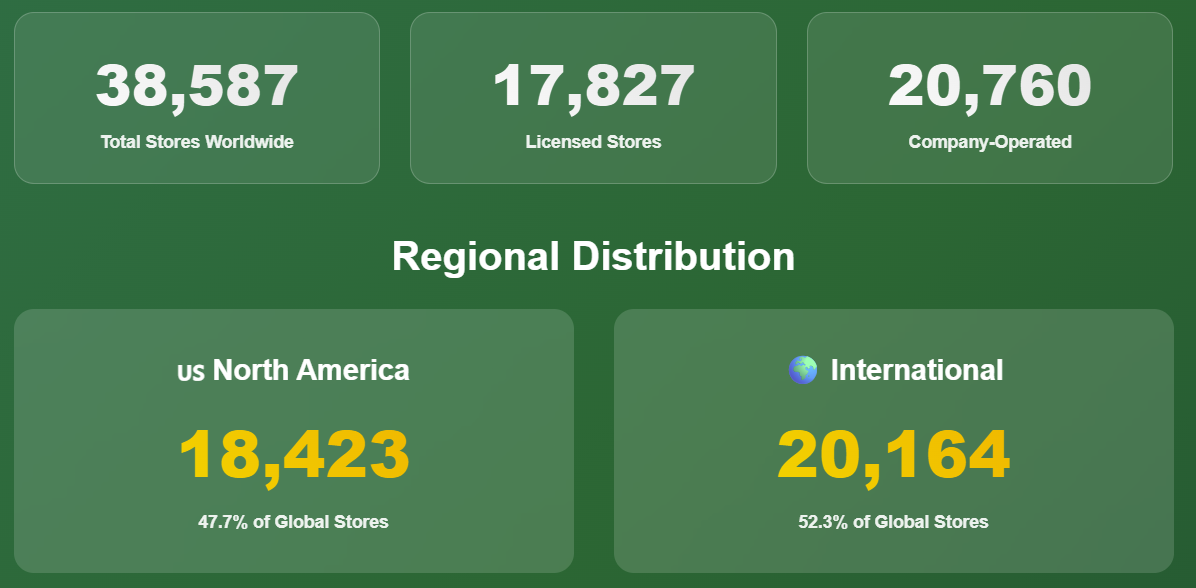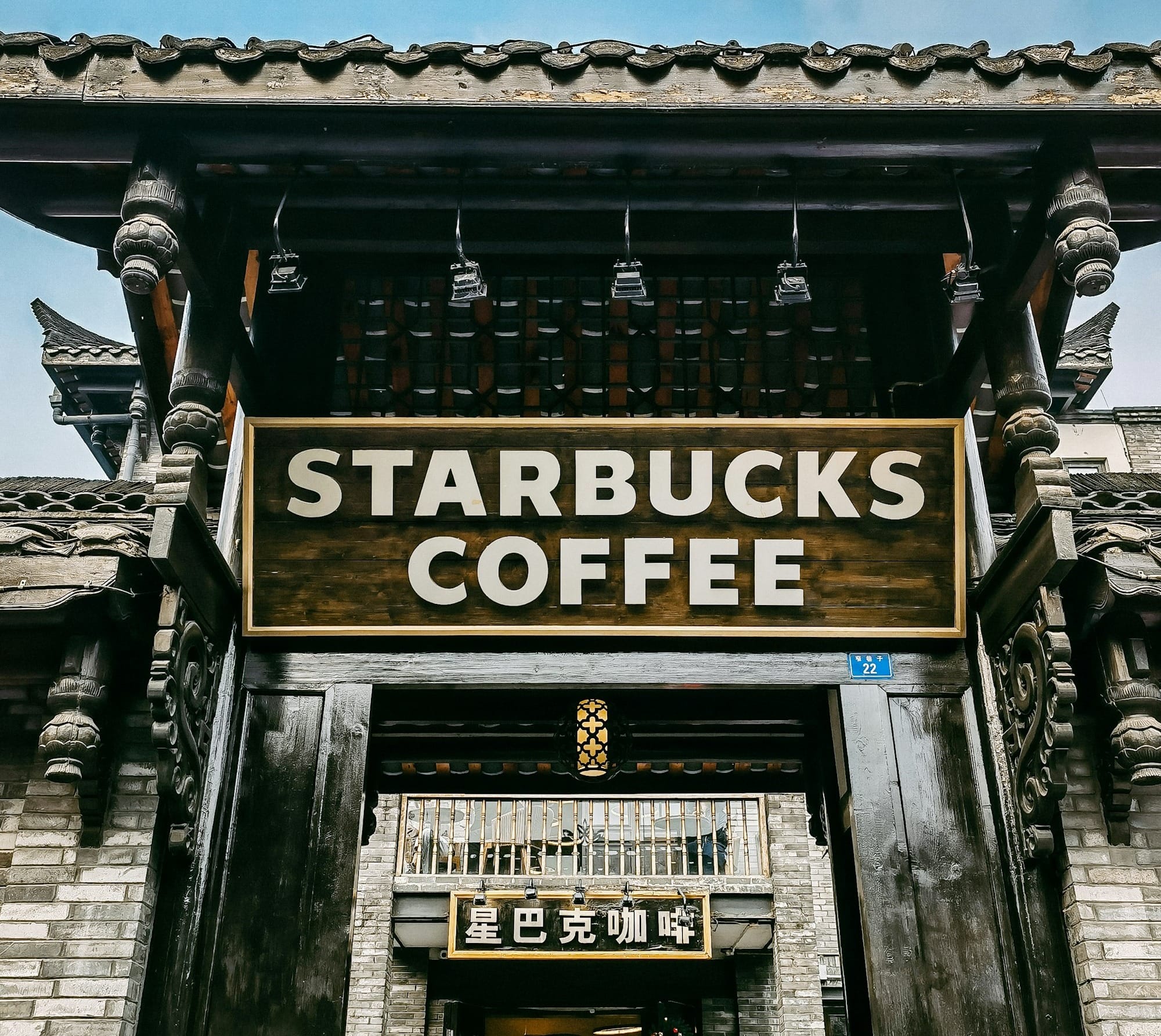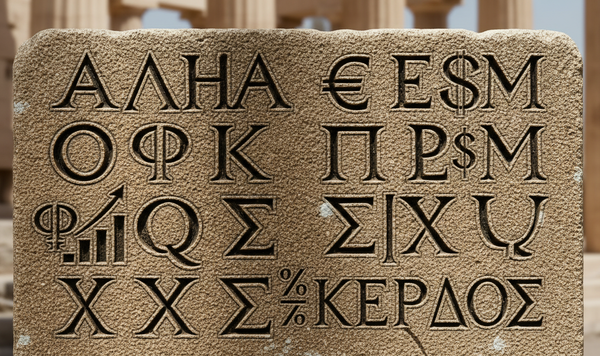Starbucks real estate strategy: the $15.8 Billion empire behind your daily latte

Ever feel like Starbucks is literally everywhere? From bustling downtown corners to random highway rest stops, those green mermaids seem to multiply faster than your credit card debt. But what most people don't realize is that Starbucks isn't just in the business of selling premium coffee - they are operating one of the most sophisticated and successful real estate investment strategies in America.
This comprehensive analysis reveals how Starbucks' property investment approach has created massive value through strategic location selection, meticulous lease optimization, and a phenomenon researchers call the "Starbucks Effect" on surrounding real estate values.
Think I'm exaggerating? Consider the data. Properties near Starbucks locations have appreciated 96% over 17 years versus just 65% for the average U.S. market. This isn't a coffee shop; it's a financial catalyst disguised as one. The company generates an immense $700 in revenue per square foot while quietly building a portfolio worth billions.
Welcome to the "Starbucks Effect" - where your morning caffeine habit reveals the blueprint for location-based wealth building that most investors completely miss.

How Starbucks' real estate investment strategy actually works
Picture this: you think you're buying coffee, but you're actually funding one of the smartest real estate plays in modern business history.
Starbucks controls a staggering $15.8 billion worth of real estate through a brilliant lease-heavy strategy - that's their $8.7 billion in owned property plus $8.4 billion in Right-of-Use assets derived from their leases. However, they carry $9.2 billion in operating lease liabilities on their balance sheet. This structure allows them to lock in long-term control of the world's most desirable locations without tying up the massive capital required for outright ownership.
Fun Fact: Starbucks spends so much on lease audits and monitoring that they've built custom software to electronically track payments and have recovered millions in landlord overpayments. They literally have a team whose job is making sure they're not getting ripped off on rent, kind of turning a standard business expense into a source of recovered revenue.
The growth of this portfolio is stunning, expanding at an 8.5% annual rate over the past decade a figure that doubles their 4.2% revenue growth rate over the same period. Simply put, their real estate game is growing faster than their coffee game.
The capital efficiency this creates is immense: for every dollar of property investment, Starbucks generates $2 in revenue (based on Q2 2025 report, $36B TTM revenue/$18B real estate control). This, combined with an investment-grade BBB+ credit rating, make landlords often line up to land them as anchor tenants. It's the equivalent of turning a $1,000 rent payment into $4,170 in income, with a credit guarantee that makes you the most sought-after tenant on the block.
Fun Fact: Starbucks opened an average of 8 new stores per day globally in Q4 2024.
The real magic, however, extends beyond their own balance sheet. The documented "Starbucks Effect" demonstrates that residential properties within a quarter-mile of a new location appreciated 31 percentage points faster than the broader market. It's like having a crystal ball for neighborhood development. That effect was at its peak during when Starbucks was in its primary U.S. growth phase, and a new store was a novel and potent signal of impending investment. However, a later HBS study showed a much smaller annual effect during a period of greater market saturation,
It's not about the real estate, it's about the system
Think of their real estate strategy as a master painter's canvas. While the canvas has inherent value and may appreciate over time, its primary purpose is to perfectly showcase the painting - in this case, the coffee experience and the power of the brand. The true value is generated by the synergy between the two.
Fun fact: in 1983, Howard Schultz took a business trip to Milan and became deeply inspired by the romance and community of Italian espresso bars. He returned to the U.S. with the vision to replicate that culture, which transformed Starbucks into the company it is today.
Analysts estimate a 60/40 split: roughly 60-70% of Starbucks' value comes from operations and brand strength, while 30-40% comes from their real estate holdings and location control. But the genius is that these percentages are completely intertwined. The real estate enables the high-margin operations, and the operations make the real estate more valuable for everyone.

Howard Schultz's philosophy was to avoid tying up capital in property ownership. This asset-light approach freed up cash to fuel a pace of global expansion that asset-heavy competitors simply could not match.
Starbucks location selection: how they pick profitable real estate
Ever wonder how Starbucks knows exactly where you'll crave a caffeine fix? Meet "Atlas" and "Deep Brew" - their proprietary location analytics platforms that make Netflix's recommendation algorithm look like a Magic 8-Ball.
The company employs over 20 global analytics experts who've divided the U.S. and Canada into 17 distinct territories. Each territory has dedicated store development offices making localized decisions while maintaining ruthlessly consistent standards. Think of it like a real estate SWAT team, but for coffee.
Their target criteria read like a dating profile for the perfect neighborhood:
- Income Level: Median household incomes above $60,000.
- Target Demographic: Urban professionals aged 18-45 with 13+ years of education. Their internal research discovered that people with more education are significantly more "experimental" with coffee flavors, making them the ideal audience for premium and seasonal drinks.
- Economic Vigor: High workforce participation rates and employment density.
- Commuter Proximity: Close to employment districts and public transportation hubs.
- Traffic Counts: A minimum of 25,000 vehicles per day.
- Commute Direction: Must be located on the "morning commute" side of the street, the peak time for coffee addiction.
- Prime Placement: Signalized corner locations with multiple entry and exit points are heavily favored.
- High Visibility: Unobstructed sightlines are mandatory, turning each store into a "brand beacon."
- Quality "Co-tenancy": Proximity to other national retailers that attract a similar, affluent customer base.
This culminates in their "Main & Main" strategy: a specific focus on targeting prime urban intersections that combine high traffic, excellent visibility, and quality neighboring businesses. Each store functions as both a sales location and a billboard for the company.
Fun Fact: Starbucks discovered that people with 13+ years of education are significantly more "experimental" with coffee flavors. So when they see a neighborhood full of college graduates, they know their Pumpkin Spice Latte experiments will land better than in areas with less formal education.
Their geographic expansion follows what can be called the "domination before exploration" approach. They use a "hub-and-spoke" model that prioritizes completely owning a home market before expanding outward. They will dominate a major city (the "hub") with substantial store density, then radiate out to nearby "spoke" markets. This maximizes operational efficiency and makes it nearly impossible for competitors to establish a meaningful presence. It’s like playing the board game Risk, but with coffee shops instead of armies.
Finally, they operate with a "First In" mentality, striving to be the first major coffee player in any new market. This gives them first pick of the best real estate. And they are willing to pay top market rates for these top-quality locations because their robust economic model can support premium rents that competitors simply can't afford.
International real estate expansion: Starbucks' global property strategy
Starbucks' global real estate strategy tells a tale of spectacular successes and billion-dollar face-plants that offer crucial lessons for any investor.
The Australia Disaster of 2000
On paper, with a big economy and thriving coffee culture, Australia looked like a golden opportunity for Starbucks. So in 2000 Starbucks went all in and by 2008 it was operating 87 stores - only to close most of them within eight years.
Starbucks learned the hard way that rapid expansion without understanding local coffee culture is like bringing a latte to an espresso fight. Australians already had European-style café culture, which was built around independent shops, highly skilled baristas, and a social, sit-down experience. The American-style, grab-and-go model with its focus on sugary, flavored drinks failed to resonate with Australian consumers, who preferred traditional espresso-based beverages.
The rapid, preemptive rollout meant that supply far outstripped organic demand. Within its first seven years, the Australian operation accumulated 105 million in losses. The failure culminated in a dramatic retreat in 2008, when Starbucks announced the closure of 61 of its 84 stores, effectively conceding that its initial strategy was a costly miscalculation.
The China Success Story
From one store in 1999 to over 7,596 locations by 2024, with plans for 9,000 by 2025. The secret to this success lies in a complete reversal of the Australian approach. Instead of imposing an American model, Starbucks adapted its offering to the local market. Key success factors include:
- Strategic partnerships: collaborating with local companies provided essential market expertise and facilitated smoother entry and expansion.
- Cultural positioning: recognizing China's historic tea culture, Starbucks positioned itself not merely as a coffee retailer but as an aspirational "third space" - a premium location for social gatherings and business meetings, and a tangible symbol of middle-class status.
- Adapted real estate: to support this positioning, stores in China are often significantly larger than their U.S. counterparts, sometimes three times the size, with more seating and a more luxurious ambiance to encourage lingering.

The company uses three different international approaches, adapting its real estate strategy to local conditions:
- Wholly-owned subsidiaries for developed markets where they desire full control.
- Joint ventures for complex markets requiring local expertise
- Licensing for rapid expansion with lower capital requirements

Simply put, they adapt their real estate strategy to local conditions while maintaining brand standards - like being a chameleon, but for commercial real estate.
Starbucks vs McDonald's: comparing retail real estate models
The strategic divergence between Starbucks and McDonald's reveals two completely different philosophies on retail real estate.
By the way, if you missed my article on McDonald’s, you can read it here!
McDonald's operates like a landlord who happens to sell burgers. They own 55% of the land and 80% of the buildings across its global portfolio. This massive real estate holding, valued at over $42 billion, allows McDonald's to generate a stable and highly predictable stream of rental income from its franchisees.
Analysis indicates that rent payments account for approximately 64% of McDonald's total franchise revenue. It's a brilliant model that creates predictable cash flows, but limits operational flexibility.
Starbucks flipped the script: they lease 90% of their locations but choose them so strategically that they create value for everyone involved. Their standard 10-year net leases with 10% rent escalations every five years give landlords predictable income while maintaining operational flexibility for Starbucks.
By leasing rather than buying, Starbucks preserves capital, enabling it to fund its rapid global expansion and to quickly pivot its store portfolio in response to changing consumer trends - a flexibility that would be impossible for an asset-heavy competitor to match.
Despite having opposite ownership models, Starbucks and McDonald's have almost the same space efficiency, with roughly $1,000 in revenue for every square foot of their retail space.

McDonald's model is perfectly designed to provide financial stability for its low-margin food business. Starbucks' model is perfectly designed to provide operational agility for its high-margin, trend-driven beverage business. Each strategy is an intelligent and tailored solution to the unique economic realities of the product being sold.
Starbucks lease management sophistication is next-level, with contracts often including:
- "Triple net" (NNN) coverage: tenants (Starbucks) pay property taxes, insurance, and common area maintenance. This structure is highly favorable for landlords because it creates a predictable, passive income stream and shields them from fluctuating operational costs. For Starbucks, it provides greater control over the property's upkeep and overall expenses.
- Exclusive use covenants: this is a clause in the lease that prevents the landlord from leasing space in the same shopping center or development to another business that primarily sells specialty coffee. As result this creates a local monopoly.
- Liberal subleasing rights: Starbucks negotiates for strong rights to sublease or assign their lease to another tenant. This serves as a vital exit strategy. If a store is underperforming or if local market dynamics shift, Starbucks can sublet the space to another business to cover its rent obligations, minimizing losses on a long-term lease.
- Broadest possible use clauses: A "use clause" defines what the tenant is allowed to do on the premises. Starbucks negotiates for very broad terms-for example, allowing for the sale of "food and beverages" rather than just "coffee." This allows them to evolve their business model over the lease term without needing to renegotiate with the landlord. They can add new food items, introduce different store concepts (like the former "Evenings" stores that served alcohol), or adapt their offerings to meet changing consumer tastes.
- Electronic monitoring software: their custom software tracks lease payments and recovers overpayments, with significant money recovered through post-lease audits.
Real estate investing lessons: the "Starbucks Effect" strategy
Here is how you can apply Starbucks' location wizardry to your own real estate investments.
- Step 1: track the expansion plans. Monitor areas where Starbucks plans new locations and consider investing in nearby properties before they open. A new Starbucks confirms that a neighborhood meets a rigorous set of data-driven criteria for growth (although it is no longer the primary catalyst for that growth).
- Step 2: use the data tools. An essential tech stack for replicating this approach includes GIS software for location analysis, demographic research platforms, market analysis tools tracking rent-to-price ratios, and population growth projections.
- Step 3: build your intelligence network. Connect with commercial real estate brokers, urban planners, and property management companies. Local market intelligence is like having cheat codes for real estate investing.

The bottom line: your latte habit is a masterclass in disguise
Next time you grab your morning coffee, take a second to appreciate the real estate genius happening around you. That corner location, that traffic pattern, that specific mix of neighboring tenants - it's all part of a financial strategy disguised as coffee culture.
Starbucks has proven that retail real estate can serve as both operational infrastructure and a powerful investment vehicle. The company's true competitive advantage lies in its dynamic ability to use real estate as a flexible, capital-efficient tool to adapt its entire business model to profound and rapid shifts in consumer behavior.
The company's ability to identify emerging markets before they become valuable offers a roadmap for individual real estate investors willing to do the homework. Success requires patience, thorough market research, and the discipline to invest based on quantitative analysis rather than gut feelings.
Simply put: master these commercial real estate location principles, and you can achieve superior investment returns by identifying valuable property opportunities before they become obvious to everyone else.
Happy investing! ☕️





